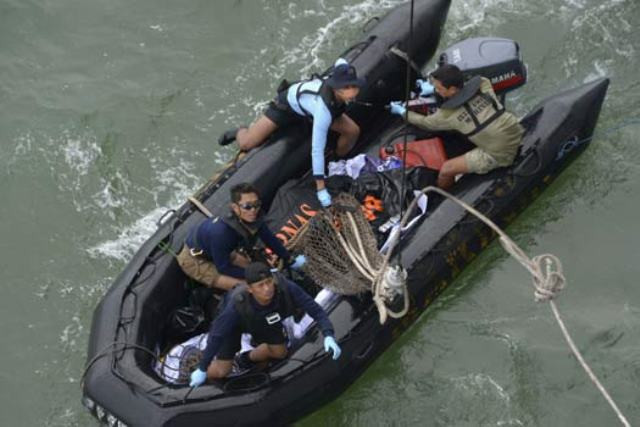Pings detected in hunt for AirAsia black box: Indonesian official
The black boxes are regarded as crucial to explaining the cause of the disaster

The black boxes are regarded as crucial to explaining the cause of the disaster. PHOTO: REUTERS
However more of the bad weather that has plagued the 13-day search for the doomed plane stopped divers from quickly tracking the ping signals to the black boxes, and frustrated efforts to lift the plane's tail from the floor of the Java Sea.
"A ship detected the pings. The divers are trying to reach it," said S B Supriyadi, a director with the National Search and Agency who is stationed at search headquarters in the town of Pangkalan Bun on Borneo island.
"The location of the ping is reported to be near where the tail was found,” he said.
The plane crashed on December 28 during stormy weather as it flew from the Indonesian city of Surabaya to Singapore, claiming the lives of all 162 people on board.
Rough seas and strong currents have slowed multinational efforts to find the wreckage of the plane, which is lying in relatively shallow waters, and determine why it crashed.
The black boxes are regarded as crucial to explaining the cause of the disaster, as they should contain recordings of the pilots' final words and general flight data.
They are designed to give a ping signal for 30 days after a crash so that the recorders can be found.
The tail of the plane, where the black boxes were housed, was discovered on Wednesday partially buried in the seabed 30 metres underwater but no pings were initially detected.
Search officials have since Wednesday focused their efforts on and around the tail, believing the black boxes should be there unless they were dislodged.
Dozens of elite Indonesian marine divers have tried but failed to thoroughly search the tail, in a task complicated by powerful currents and the fact it is partially buried in the seabed.
Those problems continued throughout Friday, with efforts to lift the tail using floatation devices scuppered by rough seas.
"We have tried (to lift the tail) but it was unsuccessful. We are still trying," Supriyadi told AFP adding that "the team there said the visibility was only one metre and they couldn't see. The current and waves were getting stronger so they couldn't work effectively."
Indonesian authorities have also brought a crane to the KRI Banda Aceh Navy vessel stationed close to the tail site, in hopes of using that to lift the wreckage.
American, Russian and other foreign naval ships are also involved in the hunt for other parts of the plane's wreckage, as well as for the bodies of passengers. Just 48 bodies have been found so far, according to Indonesian authorities.
All but seven of those on board were Indonesian. The non-Indonesians were three South Koreans, one Singaporean, one Malaysian, one Briton and a Frenchman - co-pilot Remi Plesel.
Supriyadi said another object was found on Friday that could be the nose of the plane however, searchers had yet to reach it to confirm.
"The shape of the object looked like the nose of a plane... we have deployed an ROV (remotely operated vehicle) but the visibility wasn't very good, we are trying to send divers,” he explained.
The transport ministry was expected to announce on Friday the findings of an audit into scheduling of flights in the domestic aviation industry.
The ministry launched the probe after alleging that Indonesia AirAsia did not have a permit to fly the Surabaya-Singapore route on a Sunday, the day of the crash.
It also banned Indonesia AirAsia from flying the route, while sacking one transport ministry official and taking disciplinary action against several others for allowing the flight on the Sunday.
However, investigators have not linked the lack of authorisation to the crash. The Indonesian meteorological agency has said weather was the "triggering factor", with ice likely damaging the engines of the Airbus A320-200.
Before take-off, the plane's pilot, Captain Iriyanto, had asked for permission to fly at a higher altitude to avoid a major storm. But the request was not approved due to other planes above him on the popular route, according to AirNav, Indonesia's air traffic control.
In his last communication, the experienced former air force pilot said he wanted to change course to avoid the storm. Then all contact was lost, about 40 minutes after take-off.



















COMMENTS
Comments are moderated and generally will be posted if they are on-topic and not abusive.
For more information, please see our Comments FAQ